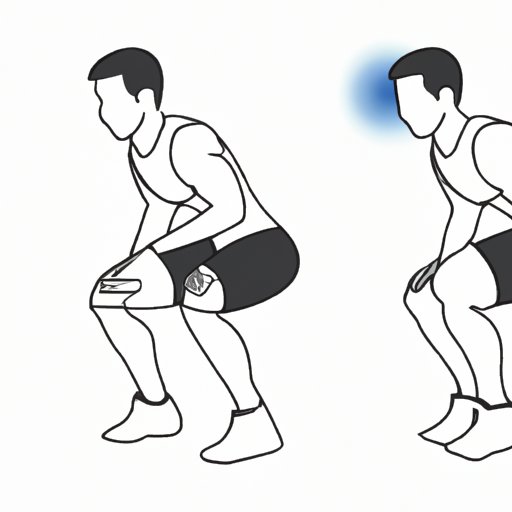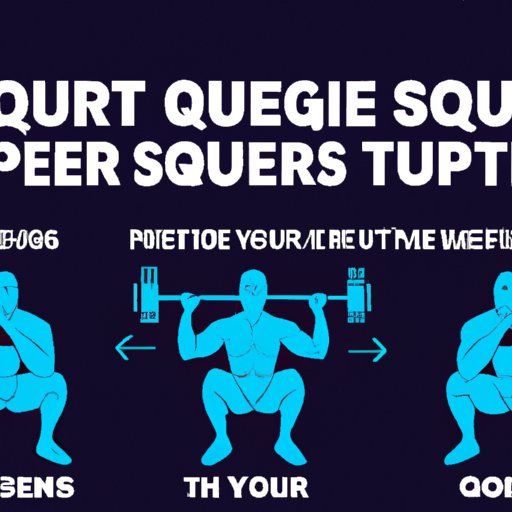
Introduction
Squats are one of the most popular exercises for toning lower body muscles and improving overall strength. They work multiple muscle groups, including the quadriceps, glutes, and hamstrings. However, performing squats with incorrect form can cause injuries and hinder any benefits you hope to achieve. In this article, we will cover the common mistakes people make when performing squats and provide tips to perfect your form and technique.
5 Common Mistakes to Avoid When Doing Squats
Before we dive into the proper technique, we need to identify the common mistakes people make when performing squats. Here are the top five to avoid:
Mistake #1: Arching Your Back
Arching your back during squats places unnecessary stress on your spine, leading to back pain and injury. Avoid arching your back by keeping your chest up, shoulders back, and core tight.
Mistake #2: Collapsing Your Knees Inward
Inward-collapse of the knee can put undue stress on your knee joints, leading to pain or injury. Keep your knees in line with your toes throughout the movement.
Mistake #3: Lifting Your Heels
If you lift your heels during squats, the weight will shift forward, and it will be challenging to keep your balance. Keeping your weight on your heels will help you prevent this common mistake. Remember to keep your feet flat on the ground and your weight on your heels.
Mistake #4: Failing to Go Low Enough
Not going low enough during squats makes them less effective. Your thighs should be parallel to the ground so that your leg muscles get a full workout. Don’t go so low that your knees extend past your toes. If you can’t go that low initially, start with partial squats and work your way up.
Mistake #5: Rounding Your Shoulders
Rounding your shoulders can cause upper back pain and neck pain. It also makes it difficult to maintain proper balance during squats. Keep your shoulders back and down, chest up, and look straight ahead.

The Ultimate Guide to Perfecting Your Squat Form
Now that we’ve gone over the most common mistakes let’s discuss the proper squat form and technique.
Proper Form and Technique
Start with feet slightly wider than hip-distance apart, toes pointing outwards. Keep your back straight, core tight, and chest up.
Lower your body by bending your knees and hips, as if you’re sitting on an imaginary chair. Your weight should be on your heels, and your knees should remain in line with your toes. Keep your chest up and your back straight.
Once you’ve gone as low as possible, push through your heels to return to standing position. Exhale during pushing up and inhale during lowering down.
How to Know When You’ve Mastered Proper Form
If your thighs reach parallel to the floor, your back remains straight, and you can maintain your balance, then you have achieved proper technique. Keep in mind that it takes time and practice to perfect your form. Start with lighter weights and gradually increase the weight as you get better.
How to Tone Your Legs and Boost Your Strength with Squats
Did you know that squats work multiple muscle groups in your lower body and also your core? That’s why squats are an excellent exercise for building strength and toning leg muscles. Here are some benefits of doing squats:
Muscles Worked During Squats
Squats work the following muscles:
- Quadriceps
- Glutes
- Hamstrings
- Calves
Benefits of Squats for Leg Strength and Toning
Regular squats have many benefits, such as:
- Toning your leg muscles like never before
- Improved flexibility and range of motion
- Helps to achieve a healthy back and good posture
- Increased overall core strength and stability
Tips to Maximize the Effectiveness of Your Squatting Routine
Here are some tips that can help you maximize the effectiveness of your squatting routine:
- Warm-up properly before your workout
- Incorporate different types of squats into your routine
- Challenge yourself by lifting heavier weights
- Make sure you rest and recover adequately between workouts
Squats 101: Understanding the Proper Technique
If you’re new to squats, it can be challenging to maintain proper form and technique. Here are some tips to get you started:
Proper Technique of Squatting for Beginners
- Keep your feet shoulder-width apart
- Bend your knees and hips, and lower your body as if you’re sitting in an imaginary chair
- Keep your back straight and chest up
- Make sure your knees stay in line with your toes
- Keep your weight on your heels while pushing up from the squat position
Tips for Maintaining Good Form While Squatting
The following tips can help you maintain good form while squatting:
- Keep your core tight
- Keep your shoulders back and chest up
- Make sure your knees stay in line with your toes
- Keep your weight on your heels throughout the entire movement
Suggest Proper Breathing Techniques While Doing Squats
Remember, proper breathing techniques are essential for better performance. Exhale during pushing up from the squat position and inhale while lowering down to complete the full squat.
The Top 3 Exercises to Improve Your Squatting Performance
Several exercises can help you improve your squatting performance. Incorporate these exercises into your routine to improve your form and technique.
Exercise #1: Squat Jumps
Squat jumps are an explosive exercise that helps to build power and speed. Begin in a squat position, then jump up explosively and land back in the starting position. Repeat this motion for several repetitions.
Exercise #2: Bulgarian Split Squats
Bulgarian split squats are a single-leg exercise that helps to build strength and stability. Stand in a split stance, place one foot behind you in a lunge position, and lower your body down into a squat position. Repeat this motion for several repetitions then switch sides.
Exercise #3: Deadlifts
Deadlifts are an exercise that work the hamstrings, glutes, and lower back. They can help you improve your strength and stability, which can enhance your squatting performance. Stand with feet about shoulder-width apart, bend at the hips and knees, and lower the weights to the floor. Return to the starting position by standing up straight with the weights in hand.
How to Prevent Knee Pain When Doing Squats
Some people experience knee pain when doing squats. Here are some tips to prevent knee pain during squats:
Potential for Knee Pain When Doing Squats
Knee pain during squats often occurs due to the following reasons:
- Putting too much weight on your knees
- Not keeping your knees aligned with your toes
- Weak knees or hips
How to Prevent Knee Pain from Occurring During Squats
The following tips will help you prevent knee pain from occurring during squats:
- Ensure your knees are always pointing in the same direction as your toes
- Start with lighter weights and gradually increase the amount of weight
- Keep your heels grounded
Remember, proper warm-up, and stretching are essential before starting any workout activities.
The Benefits of Incorporating Squats into Your Exercise Routine
Incorporating squats into your exercise routine comes with many benefits:
Benefits of Incorporating Squats into Your Regular Exercise Routine
- Burns more calories
- Strengthens core muscles
- Lowers the risk of injury
- Improves balance and stability
Mention of Potential for Increased Calorie Burning with Squats
Since squats work several muscle groups simultaneously, including big muscle groups like legs and glutes, it’s an effective way for the body to burn more calories. Adding squats to your exercise routine can help you burn more calories and achieve your weight loss goals faster.
How Squats Can Improve Overall Physical Fitness
Squats help to improve overall physical fitness by enhancing balance, coordination, and flexibility. Furthermore, they increase your stamina, agility, and endurance, making it easier to perform any daily activities.
Conclusion
Squats are an excellent exercise for toning lower body muscles and boosting overall strength. By following the proper technique and form, you can maximize the benefits of squats, including toning muscles, strengthening muscles, burning calories, and reducing the risk of injuries. Remember, it takes practice to perfect technique, so be patient and progressively increase the weight used. Incorporate squats into your exercise routine today for better leg and total-body strength.
So, everybody, start doing squats using this ultimate guide, but not before proper warm-ups and stretching to feel the progress of being fit.





